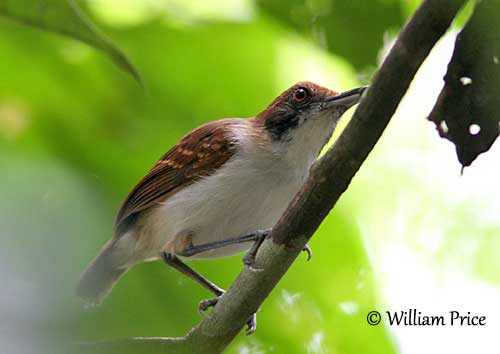
PROTECTION / THREATS / STATUS:
The Ash-breasted Antbird is fairly common throughout its range, but it is threatened by accelerating deforestation in the Amazon Basin and land clearing for cattle and soy production. It is also affected by forest fragmentation.
The size of the population is unknown, but in spite of decline of numbers, the species is described as fairly common.
But currently, the Ash-breasted Antbird is listed as Vulnerable.
Fr: Alapi lugubre
Ang: Ash-breasted Antbird
All: Várzeaameisenschnäpper
Esp: Hormiguero Lúgubre
Ita: Formichiere pettocenere
Nd: Asborstmierkruiper
Sd: várzeamyrfågel
Photographers:
Roger Ahlman
Pbase Galleries Peru and Ecuador & My bird pictures on IBC
William Price
PBase-tereksandpiper & Flickr William Price
Text by Nicole Bouglouan
Sources:
HANDBOOK OF THE BIRDS OF THE WORLD Vol 8 By Josep del Hoyo-Andrew Elliott-David Christie - Lynx Edicions - ISBN: 8487334504
BIRDS OF SOUTH AMERICA – Passerines - by Robert S. Ridgely and Guy Tudor – HELM Field Guides – ISBN: 9781408113424
The Birds of South America: Vol. II, The Suboscine Passerines De Robert S. Ridgely, Guy Tudor, William L. Brown, World Wildlife Fund – Editeur: University of Texas Press, 1989 – ISBN: 0292770634, 9780292770638 – 940 pages
Neotropical Birds – Cornell Lab of Ornithology
Wikipedia, la enciclopedia libre
Ash-breasted Antbird
Myrmoborus lugubris
Passeriformes Order – Thamnophilidae Family
INTRODUCTION:
The Ash-breasted Antbird was first described by the German ornithologist Jean-Louis Cabanis in 1847. Four subspecies share the linear range along the Amazon, between NE Peru and the river mouth in State of Pará, Brazil.
It favours dense undergrowth in lowland forest along the river, and occurs on river islands and banks of the Amazon and large tributaries. This species is an insect-eater and often occurs alone or in pairs, and also in family groups.
The Ash-breasted Antbird is threatened by heavy deforestation in the Amazon Basin, and forest fragmentation. It is currently listed as Vulnerable.
DESCRIPTION OF THE BIRD:
Biometrics:
Length: 13,5 cm
Weight: 20-23 g
The Ash-breasted Antbird male of nominate race has bluish-grey crown and upperparts, but the forehead is paler, mostly whitish-grey, contrasting with black face and throat. Wings and tail are slightly darker.
The underparts are pale grey with darker flanks. Centre of belly is whitish.
The bill is blackish. The eyes are red. Legs and feet are grey.

The female has pale rufous-brown head and upperparts, but she lacks the black mask through the eyes. The wing-coverts show indistinct buff dotting.
The underparts are white but the breast is washed pale grey whereas the flanks are pale yellowish-brown.
The juvenile is not described.
SUBSPECIES AND RANGE:
The Ash-breasted Antbird has four subspecies, but the males are fairly similar to each other.
M.l. berlepschi (displayed) is found in E Ecuador (extreme E Orellana), NE Peru (Loreto) and extreme W Amazonian Brazil.
The female has olive tinge on crown and upperparts, reddish yellow-brown wing-coverts, and black mask including lores, ocular area and ear-coverts. The throat is white with indistinct band of dark spots on the lower part. The underparts are grey, mostly whitish on belly.
M.l. stictopterus (displayed) occurs in C Amazonian Brazil.
The female of this race differs from the previous in more rufous tinge on the upperparts, whereas underparts are paler. The black mask is more extensive and reaches the sides of the lower neck.

M.l. stictopterus
Female
M.l. feminimus (not displayed) is found in lower R Madeira in SC Amazonian Brazil.
The female resembles previous with more rufescent upperparts and darker underparts.
M.l. lugubris (described above but not displayed) occurs in R Amazon, from R Madeira E to Baía do Guajará (CE Amazonas, NC Pará).
HABITAT:
The Ash-breasted Antbird occurs primarily on river islands in the Amazon and the largest tributaries, and on Amazon’s banks. It frequents the understorey of the lowland evergreen forest at river edge.
Throughout the range, it occurs in varzea forest on the mainland banks of river, in swamp thickets of Heliconia and taller groves of Cecropia forest.
CALLS AND SONGS: SOUNDS BY XENO-CANTO
The Ash-breasted Antbird gives a rapid, descending, metallic chatter “pt’ rr’ rr’ rr” and also a quiet single or doubled “pew” note. We can also hear a sharp “jeet”.
The song is a loud, rapid, descending series of “jee” notes described as “JEE-JEE-jee-jee-jee-jee-jee-jee-jer”.

BEHAVIOUR IN THE WILD:
The Ash-breasted Antbird feeds on insects and spiders. It forages alone or in pairs, within 1 metre of the ground. The prey are caught by pecking or short-distance sallies (less than 30 cm). It also clings to vertical stems of Heliconia or hops on the ground. It usually moves from perch to perch with hops and short flights.
The antbirds are usually monogamous and pair for life. The territory is defended all year round.
Courtship feeding by male to female is observed prior to copulation.
The Ash-breasted Antbird is probably resident.
They have short, rounded wings. The flight is direct and typically slow and fluttering.

REPRODUCTION OF THIS SPECIES:
The Ash-breasted Antbird breeds during periods of low water levels, usually in seasonally flooded areas. The nest is often on or just off the ground, hidden among leaf litter, tree roots and organic debris.
A nest was described from the observation of a single nest in C Brazil in September (Zimmer and Isler 2003).
It was a dome-shaped structure of 15 cm high with side entrance at ground level. Outside, the nest was made with dead leaves and some thin dead twigs. It was very cryptic among the leaf litter. A partially decomposed leaf of about 15 cm long was placed about 1 centimetre above the entrance. The nest was placed on the ground, close to low plants but higher than the nest roof.
Most antbird species lay two eggs of cryptic colour. Both adults develop brood patches and share the incubation, the female at night and the male during the day. Both parents feed the chicks and share the nesting duties.
